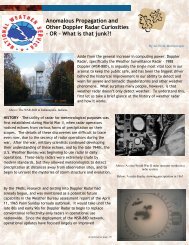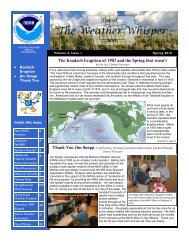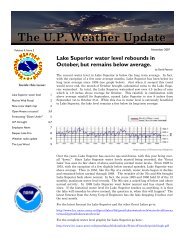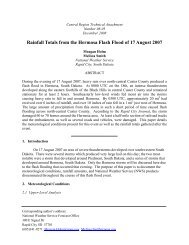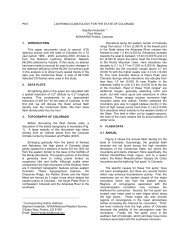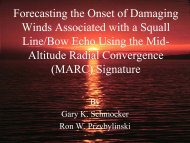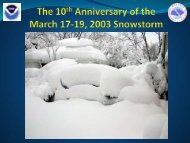A Grassroots Project at WFO Riverton - Central Region ...
A Grassroots Project at WFO Riverton - Central Region ...
A Grassroots Project at WFO Riverton - Central Region ...
Create successful ePaper yourself
Turn your PDF publications into a flip-book with our unique Google optimized e-Paper software.
R I V E R T O N<br />
N A T I O N A L W E A T H E R<br />
S E R V I C E O F F I C E<br />
Inside this issue:<br />
J A N U A R Y 1 5 , 2 0 1 0<br />
Women - Men in Science 2<br />
Wyoming Educ<strong>at</strong>ion<br />
Network (WEN)<br />
2<br />
StormReady Continues to<br />
Grow<br />
New Hail Criterion for<br />
Severe Thunderstorms<br />
Meteorologists Conduct<br />
Hail Research<br />
Winter Storm and Severe<br />
We<strong>at</strong>her Performance<br />
Training Volunteers to<br />
Measure Precipit<strong>at</strong>ion<br />
Fire We<strong>at</strong>her<br />
Improvements<br />
Cooper<strong>at</strong>ive We<strong>at</strong>her<br />
Observer Program<br />
Cre<strong>at</strong>e Your Own<br />
We<strong>at</strong>her Report<br />
New Clim<strong>at</strong>e D<strong>at</strong>a<br />
Products<br />
3<br />
4<br />
4<br />
5<br />
5<br />
6<br />
6<br />
7<br />
7<br />
A <strong>Grassroots</strong> <strong>Project</strong> <strong>at</strong> <strong>WFO</strong> <strong>Riverton</strong><br />
On August 25, 2009, Union Pass, Wyoming, became the<br />
very first community in the n<strong>at</strong>ion to become<br />
“WildfireReady.” Shortly thereafter, Teton County,<br />
Wyoming, was recognized as the first WildfireReady<br />
County in the n<strong>at</strong>ion on September 1, 2009.<br />
Both Union Pass and Teton County expressed a strong<br />
interest in having a preparedness program dealing with<br />
the hazard of fire in the wildland-urban interface.<br />
Additionally, Teton County and Grand Teton N<strong>at</strong>ional<br />
Park have cooper<strong>at</strong>ed to earn the distinctive honor of<br />
being the n<strong>at</strong>ion’s first WildfireReady county and<br />
n<strong>at</strong>ional park, respectively. WildfireReady is modeled<br />
after the N<strong>at</strong>ional We<strong>at</strong>her Service’s (NWS) highly<br />
successful StormReady ® Program which assists<br />
communities in improving hazardous we<strong>at</strong>her<br />
communic<strong>at</strong>ions and preparedness activities.<br />
It is hopeful th<strong>at</strong> WildfireReady will gain more regional<br />
and n<strong>at</strong>ional <strong>at</strong>tention in years to come. The demand for<br />
Fire We<strong>at</strong>her Services across the United St<strong>at</strong>es continues<br />
to quickly grow, as each year wildfires consume a gre<strong>at</strong><br />
extent of n<strong>at</strong>ure’s landscape. As part of WildfireReady,<br />
the NWS educ<strong>at</strong>es communities about preparing for<br />
favorable or extreme fire we<strong>at</strong>her conditions, especially<br />
d u r i n g t h e f i r e w e a t h e r s e a s o n .<br />
Group photo from the Union Pass WildfireReady<br />
dedic<strong>at</strong>ion ceremony August 25, 2009. Holding the<br />
WildfireReady recognition sign is Dale Corkill of the<br />
Union Pass Emergency Preparedness Council.<br />
Gage Install<strong>at</strong>ions 8<br />
Hydrology <strong>Project</strong>s 8-9<br />
Graphical We<strong>at</strong>her Story 9<br />
Both Union Pass and Teton County held recognition<br />
ceremonies <strong>at</strong>tended by Emergency Management,<br />
n<strong>at</strong>ional park, and forest service officials, as well as the<br />
general public. The photos <strong>at</strong> left are from this past<br />
summer’s ceremonies.<br />
If you would like more inform<strong>at</strong>ion about becoming<br />
WildfireReady, please contact either Kevin Lynott or Chris Jones <strong>at</strong>:<br />
Kevin Lynott (right) presented a WildfireReady sign to<br />
Jason Biermann, Rich Ochs (Teton County Emergency<br />
Management), and He<strong>at</strong>her Voster (NPS) in Jackson.<br />
Kevin Lynott (307) 857-3898 x642 Kevin.Lynott@noaa.gov<br />
Chris Jones (307) 857-3898 x726 Chris.Jones@noaa.gov
P A G E 2<br />
On the morning of October 2, 2009, over 300 young women in<br />
grades 7 through 12 g<strong>at</strong>hered <strong>at</strong> <strong>Central</strong> Wyoming College.<br />
These young women were the participants in the fifth Women<br />
in Science Conference, an all-day event where students are able<br />
to interactively learn about various careers in the fields of<br />
m<strong>at</strong>h, science, and technology. Students were able to<br />
particip<strong>at</strong>e in two, one-hour breakout sessions during which<br />
they were able to meet with professionals in various fields to<br />
have an interactive introduction to their careers. Some of the<br />
represented careers included were Optometry, Str<strong>at</strong>egic<br />
Planning, Physics, Geology, Radiology, Hydrology,<br />
Veterinarian Science, Paleontology, Forensic Science,<br />
P<strong>at</strong>hology, Physical Therapy, and others. These sessions were<br />
prefaced by a Keynote Speaker, Dr. Michele Tuttle, who spoke<br />
of her experiences as a research geochemist. Feedback from<br />
students, teachers, and speakers was quite positive from this<br />
annual event.<br />
Women - Men in Science<br />
NOAA’s N<strong>at</strong>ional We<strong>at</strong>her Service has been heavily involved in<br />
the development of these conferences, resulting in several<br />
we<strong>at</strong>her service employees filling the roles of officers, board<br />
members, planning committee members, and/or volunteers on<br />
the day of the conference. The planning committee meets<br />
throughout the year on a monthly basis to organize the number<br />
of break-out session presenters, keynote speakers, sponsors,<br />
vendors, volunteers, and to search for grant opportunities for<br />
additional funding. Attendance has increased over the years and<br />
is now limited to a first-come, first-served basis due only to<br />
limited resources. With the continued success of these events,<br />
Interacting with Wyoming Students - Wyoming Educ<strong>at</strong>ion Network (WEN)<br />
Efforts are in the works for the N<strong>at</strong>ional We<strong>at</strong>her Service in <strong>Riverton</strong> to<br />
begin utilizing the Wyoming Educ<strong>at</strong>ion Network (WEN) in order to reach a<br />
wider audience of schools across central and western Wyoming. The WEN<br />
is a distance learning tool used between schools, which provides a video<br />
and audio link. Students from many areas can then w<strong>at</strong>ch the same<br />
presenter <strong>at</strong> the same time, and can even have an interactive session with<br />
their instructor in order to ask or answer questions. The N<strong>at</strong>ional We<strong>at</strong>her<br />
Service in <strong>Riverton</strong> is working out details to partner with <strong>Central</strong> Wyoming<br />
College to utilize their WEN classroom in order to conduct these talks.<br />
Preliminary d<strong>at</strong>es are Thursday, February 11, and Thursday, April 15. Both<br />
WEN sessions will begin <strong>at</strong> 1:30 p.m. for these events are forthcoming;<br />
please check our website for upd<strong>at</strong>es concerning this exciting advancement!<br />
the Women/Men in Science Planning Committee will continue<br />
to altern<strong>at</strong>e events each year pending adequ<strong>at</strong>e funding which is<br />
acquired through grants and local sponsorships. Plans are in<br />
development for a second Men in Science Conference which<br />
will be held in October of 2010. If you have questions, or would<br />
like to become involved in these conferences, please contact<br />
K<strong>at</strong>y Branham or Peggy Peterson <strong>at</strong> 307-857-3898 (x381 for<br />
P e g g y ) o r t h r o u g h o u r E m a i l a d d r e s s e s :<br />
K<strong>at</strong>y.Branham@noaa.gov and Peggy.Peterson@noaa.gov
P A G E 3<br />
StormReady Continues to Grow - Grand Teton First StormReady N<strong>at</strong>ional Park<br />
The number of StormReady ® communities in western Wyoming grew by three this year as Grand Teton N<strong>at</strong>ional Park, N<strong>at</strong>rona<br />
County, and the Casper/N<strong>at</strong>rona County Intern<strong>at</strong>ional Airport came on board. StormReady ® , a NWS program th<strong>at</strong> began in 1999,<br />
assists communities in establishing communic<strong>at</strong>ion systems and increasing public safety awareness. Ultim<strong>at</strong>ely, the goal of<br />
StormReady ® is to better prepare for the hazards of severe we<strong>at</strong>her to help save lives and property.<br />
“StormReady ® was designed for communities to be proactive in improving hazardous we<strong>at</strong>her oper<strong>at</strong>ions and communic<strong>at</strong>ions," said<br />
Chris Jones, Warning Coordin<strong>at</strong>ion Meteorologist of the <strong>Riverton</strong> NWS office. “Enhanced communic<strong>at</strong>ion services are a<br />
requirement of particip<strong>at</strong>ion in the StormReady ® program.” In the case of Grand Teton N<strong>at</strong>ional Park, park officials are now better<br />
equipped to communic<strong>at</strong>e important hazard inform<strong>at</strong>ion to save lives and property, before and during the event. Several different<br />
methods of relaying we<strong>at</strong>her inform<strong>at</strong>ion were established or enhanced through the StormReady ® certific<strong>at</strong>ion process.<br />
"At Grand Teton N<strong>at</strong>ional Park, we take seriously our role in providing a<br />
safe environment for both the local Jackson Hole community, and for the<br />
millions of people who visit the park each year. As a new StormReady ®<br />
agency, we intend to do all we can to alert local residents and park visitors to<br />
severe we<strong>at</strong>her events, whenever the situ<strong>at</strong>ion arises," said Superintendent<br />
Mary Gibson Scott. "Being the first n<strong>at</strong>ional park to achieve StormReady ®<br />
st<strong>at</strong>us is especially gr<strong>at</strong>ifying, and we hope to serve as an example for others<br />
to follow."<br />
N<strong>at</strong>rona County was recognized as StormReady ® during N<strong>at</strong>ional<br />
Preparedness month in September. Lt. Stew Anderson, N<strong>at</strong>rona County<br />
Emergency Manager, and his deputy, Theresa Simpson, have been proactive<br />
in the establishment of redundant communic<strong>at</strong>ion systems throughout the<br />
county, including new outdoor warning sirens around Casper. Also,<br />
emergency management personnel have multiple ways in which to receive<br />
we<strong>at</strong>her alerts, spotter training is routinely taught in several loc<strong>at</strong>ions around<br />
the county each spring, and Lt. Anderson and Mrs. Simpson are quick to<br />
provide vital storm reports to the NWS.<br />
Casper/N<strong>at</strong>rona County Intern<strong>at</strong>ional Airport completed the necessary<br />
requirements for StormReady ® design<strong>at</strong>ion in November. Leah Henderson,<br />
airport <strong>Project</strong> and Programs Manager, led the process of improving we<strong>at</strong>her<br />
preparedness <strong>at</strong> the airport. This included the development of a Severe<br />
We<strong>at</strong>her Emergency Plan and placing NOAA We<strong>at</strong>her and All-Hazards<br />
Radio receivers <strong>at</strong> various loc<strong>at</strong>ions on the airport premises.<br />
Chris Jones (far left) and Kevin Lynott (far right) of the NWS in<br />
<strong>Riverton</strong> present a StormReady ® recognition sign to He<strong>at</strong>her<br />
Voster (behind sign) and Superintendent Mary Gibson Scott of the<br />
N<strong>at</strong>ional Park Service – Grand Teton N<strong>at</strong>ional Park.<br />
Some of the particular criteria th<strong>at</strong> must be met in order to be recognized as a StormReady ® community are:<br />
Establish a 24-hour warning point and emergency oper<strong>at</strong>ions center;<br />
Have redundant ways to receive we<strong>at</strong>her forecasts and warnings and to alert the public;<br />
Cre<strong>at</strong>e a system th<strong>at</strong> monitors local we<strong>at</strong>her conditions;<br />
Promote the importance of public readiness through community seminars;<br />
Develop a formal hazardous we<strong>at</strong>her plan for training severe we<strong>at</strong>her spotters and holding emergency exercises.<br />
Previously recognized StormReady ® communities in western Wyoming are<br />
Teton and Hot Springs counties and the town of Greybull. More communities<br />
are already working on StormReady ® certific<strong>at</strong>ion for 2010, including one<br />
town and a community college. People interested in pursuing StormReady ®<br />
accredit<strong>at</strong>ion are encouraged to contact Chris Jones, NWS <strong>Riverton</strong>, <strong>at</strong> (307)<br />
857-3898 ext. 726.
P A G E 4<br />
New Hail Criterion for Severe Thunderstorms<br />
An historic change to the NWS criterion to define the size of hail c<strong>at</strong>egorizing a thunderstorm as severe was implemented by selected<br />
we<strong>at</strong>her forecast offices in the central United St<strong>at</strong>es and Rocky Mountain region on April 1, 2009. The NWS <strong>Riverton</strong> office was a<br />
participant in this change, which has now been implemented n<strong>at</strong>ionwide. The old standard of three-quarter inch diameter hail for<br />
design<strong>at</strong>ing a thunderstorm severe has been replaced by the new standard of one inch diameter hail.<br />
For the past four years, the NWS offices in Kansas served as a test bed to<br />
measure the efficiency of using one inch diameter as the criterion for severe<br />
thunderstorms. One of the motiv<strong>at</strong>ions for this experiment was the perception<br />
th<strong>at</strong> numerous warnings for thunderstorms th<strong>at</strong> produced hail of little damage<br />
or was not unusual would cause the public to view these warnings as only a<br />
minor thre<strong>at</strong>. During the four-year Kansas project, customer feedback was<br />
collected with a very favorable response to the new criterion from emergency<br />
managers and the media. With the new criterion in place, public surveys<br />
concluded people were more likely to take action to protect themselves and<br />
their property. Another opinion voiced in the survey was th<strong>at</strong> many people<br />
were happier not having television programs interrupted as frequently.<br />
Forecasts for those thunderstorms producing hail less than one inch in diameter<br />
and/or wind gusts less than 58 mph, but still capable of producing a thre<strong>at</strong> to<br />
lives and property, are detailed in NWS short term forecasts (for minor thre<strong>at</strong><br />
events) and significant we<strong>at</strong>her advisories (for storms near severe thresholds).<br />
Another important thing to remember when reporting hail is to reference coin<br />
Meteorologists Conduct Research to Possibly Improve Severe Thunderstorm Detection<br />
Research comparing radar d<strong>at</strong>a, height of the freezing level, and hail reports is being conducted by meteorologists <strong>at</strong> the NWS<br />
<strong>Riverton</strong> office. The methodology is similar to th<strong>at</strong> used by meteorologists <strong>at</strong> the NWS Des Moines, IA office who sought a better<br />
way to determine which thunderstorms were producing severe sized hail.<br />
Researchers can evalu<strong>at</strong>e storm <strong>at</strong>tributes on radar by loading past thunderstorm<br />
events into the NWS <strong>Riverton</strong>’s We<strong>at</strong>her Event Simul<strong>at</strong>or (WES). The WES<br />
allows researchers to replay events and evalu<strong>at</strong>e specific thunderstorm<br />
characteristics using radar d<strong>at</strong>a. Similarly, the WES can be used as a training<br />
resource by placing forecasters into a real-time scenario to improve diagnostic,<br />
interpret<strong>at</strong>ion, and software oper<strong>at</strong>ion skills.<br />
Thunderstorms th<strong>at</strong> produced hail reports of <strong>at</strong> least 0.75 inches in diameter<br />
(since 2002) are being evalu<strong>at</strong>ed for the study. Past d<strong>at</strong>a from we<strong>at</strong>her forecast<br />
models is then reviewed to determine the approxim<strong>at</strong>e height of the freezing<br />
level during the hailstorm. The d<strong>at</strong>a is then plotted on a graph to determine if<br />
any strong correl<strong>at</strong>ion exists between wh<strong>at</strong> is seen on radar and wh<strong>at</strong> size hail<br />
falls on the ground. Researchers have completed review of all storms during the<br />
period 2002 through 2009. The hope now is to determine if there are some<br />
helpful radar sign<strong>at</strong>ures pertinent to western Wyoming where forecasters might<br />
better distinguish between severe and non-severe thunderstorms. Potentially this<br />
would help improve detection of severe thunderstorms while <strong>at</strong> the same time<br />
limiting the number of warnings issued for storms th<strong>at</strong> are non-severe.<br />
Tree damage <strong>at</strong> the <strong>Riverton</strong> Country Club following a 74 mph<br />
wind gust on July 27, 2009. At least a dozen m<strong>at</strong>ure trees<br />
were damaged on the course.<br />
sizes or the sizes of various sports balls (e.g., ping pong ball, golf ball, tennis ball, baseball). Also, be sure to distinguish hail th<strong>at</strong> is<br />
quarter-sized (coin), denoting one inch diameter hail, and th<strong>at</strong> of one-quarter inch diameter hail (roughly pea size). We hope this<br />
new criterion for hail in a severe thunderstorm serves you and your customers well, and we invite your feedback on this fundamental<br />
change to severe thunderstorm criteria.<br />
Hail up to the size of tennis balls fell on the east side of<br />
Greybull around 5:15 p.m. on August 7, 2009. Severe<br />
thunderstorm warnings and a tornado warning were issued<br />
well in advance of the storm.
P A G E 5<br />
Winter Storm and Severe We<strong>at</strong>her Performance<br />
One of the methods by which the <strong>Riverton</strong> NWS office assesses its performance is through the verific<strong>at</strong>ion of winter storm and<br />
severe thunderstorm warnings. Each year the office reviews methods which could improve and enhance services. Also, local office<br />
st<strong>at</strong>istics can be helpful in identifying specific loc<strong>at</strong>ions where warning services lag behind office averages and goals.<br />
A review of winter storm warnings from the 2008-09 season reveals th<strong>at</strong> NWS <strong>Riverton</strong> issued 223 warnings, which was double the<br />
average of the previous five-year period. The wet and active spring season helped to put an end to the prolonged drought and<br />
significantly increased the issuance of winter storm warnings. The accuracy r<strong>at</strong>e of 90% was on par with the Government<br />
Performance and Results Act (GPRA) goal. Lead time from issuance to event occurrence was nearly 16 hours, which was higher<br />
than the GPRA goal of 15 hours. Despite the high number of warnings, the false alarm r<strong>at</strong>e of 43% was nearly 10 percentage points<br />
less than the season before. Local goals for this season are to increase accuracy while <strong>at</strong> the same time continuing to improve the<br />
false alarm r<strong>at</strong>e.<br />
As for severe thunderstorm warning performance, the numbers indic<strong>at</strong>ed a slight dip from wh<strong>at</strong> has been seen<br />
over much of this decade. The accuracy r<strong>at</strong>e of 58% was less than the eight-year average of 67%. Also,<br />
NWS <strong>Riverton</strong> provided average lead time of 12.5 minutes to the first reported severe we<strong>at</strong>her event, about<br />
one minute under the eight-year average. The warning false alarm r<strong>at</strong>e was one bright spot dropping to 69%<br />
after five years of averaging above 75%. Incidentally, there are no GPRA goals for severe thunderstorm<br />
warnings, just tornado warnings which comprise a very small sample size in western Wyoming.<br />
One way the <strong>Riverton</strong> NWS office is trying to address improvement in severe thunderstorm<br />
warning verific<strong>at</strong>ion is with continued outreach through the severe we<strong>at</strong>her spotter training<br />
program. In 2009, <strong>WFO</strong> <strong>Riverton</strong> gave 25 spotter talks with a total <strong>at</strong>tendance of 265.<br />
Storm spotters, especially in rural and sparsely popul<strong>at</strong>ed areas like western Wyoming, are<br />
vital to assisting forecasters with ground-truth reports as to wh<strong>at</strong> the storm is actually<br />
producing. Obtaining spotter reports can not only help forecasters issue more timely<br />
warnings but also assist in verifying valid warnings. These reports can also be used after<br />
the fact to conduct studies th<strong>at</strong> may further assist meteorologists in differenti<strong>at</strong>ing between<br />
severe and non-severe thunderstorms (read more on page 4 about ongoing hail research).<br />
Anyone interested in having their agency or group host a severe we<strong>at</strong>her spotter’s class is<br />
encouraged to contact Chris Jones, NWS <strong>Riverton</strong>, <strong>at</strong> (307) 857-3898 ext. 726. The<br />
training is gre<strong>at</strong> for rural firefighters, farm and ranch groups, church and civic groups,<br />
mining and drilling oper<strong>at</strong>ors, and outdoor enthusiasts.<br />
Training Volunteers to Measure & Report Precipit<strong>at</strong>ion<br />
NWS <strong>Riverton</strong> meteorologists conducted precipit<strong>at</strong>ion measurement training this fall in support of the Community<br />
Collabor<strong>at</strong>ive Rain, Hail & Snow Network (CoCoRaHS). Training was conducted <strong>at</strong> ten sites around western and<br />
central Wyoming. CoCoRaHS is a grassroots program where volunteers report daily precipit<strong>at</strong>ion online. These<br />
observ<strong>at</strong>ions go into a n<strong>at</strong>ional d<strong>at</strong>abase th<strong>at</strong> is free and accessible to all. Daily precipit<strong>at</strong>ion reports are mapped on<br />
the CoCoRaHS homepage.<br />
CoCoRaHS was founded in 1998 <strong>at</strong> the Colorado Clim<strong>at</strong>e Center <strong>at</strong> Colorado St<strong>at</strong>e University and has<br />
since grown to over 15,000 volunteer observers. With the addition of 12 new st<strong>at</strong>es in 2009, CoCoRaHS<br />
is now active in all 50 st<strong>at</strong>es and the District of Columbia.<br />
The training session teaches volunteers how to properly measure rain and snow while introducing them to<br />
the equipment used by current CoCoRaHS observers. Also included is a tour of the CoCoRaHS website<br />
and inform<strong>at</strong>ion about how to join CoCoRaHS and how to obtain precipit<strong>at</strong>ion measuring equipment.<br />
We look forward to conducting more training sessions in the fall of 2010. Check our website <strong>at</strong> http://<br />
www.we<strong>at</strong>her.gov/riverton for times and loc<strong>at</strong>ions as fall approaches. More inform<strong>at</strong>ion about<br />
CoCoRaHS and how you can become an observer can be found <strong>at</strong> http://www.cocorahs.org.
P A G E 6<br />
Fire We<strong>at</strong>her Improvements<br />
After receiving customer feedback from the annual fire we<strong>at</strong>her user<br />
meeting in February of 2009, the <strong>Riverton</strong> fire we<strong>at</strong>her team decided to<br />
implement three separ<strong>at</strong>e discussion sections in the fire we<strong>at</strong>her forecast<br />
product to better describe the expected we<strong>at</strong>her in particular clim<strong>at</strong>ic<br />
regions of the st<strong>at</strong>e (Figure 1). The separ<strong>at</strong>e sections also allow the<br />
Federal Agency disp<strong>at</strong>cher the ability to brief crews in their particular<br />
disp<strong>at</strong>ch area and not have to spend valuable radio time reading we<strong>at</strong>her<br />
inform<strong>at</strong>ion not pertinent to their area. So far, the discussion split has<br />
been met with cheers. The <strong>Riverton</strong> fire we<strong>at</strong>her team is currently<br />
cre<strong>at</strong>ing a concise Disp<strong>at</strong>ch Area Forecast (DAF) product to further<br />
reduce the time disp<strong>at</strong>chers have to spend reading zones forecasts<br />
relevant to their district.<br />
Figure 1: Map showing the three different areas for the Fire We<strong>at</strong>her<br />
The <strong>Riverton</strong> N<strong>at</strong>ional We<strong>at</strong>her Service office supports 83 Cooper<strong>at</strong>ive Observer<br />
(COOP) sites across western and central Wyoming. The observers <strong>at</strong><br />
each of the 12,000 COOP sites loc<strong>at</strong>ed across the United St<strong>at</strong>es, and many of<br />
its territories, are volunteers who daily collect high and low temper<strong>at</strong>ures, as<br />
well as rain and snowfall amounts from NWS supplied instruments. These<br />
sites, and their vital we<strong>at</strong>her d<strong>at</strong>a, are the backbone of the n<strong>at</strong>ional clim<strong>at</strong>e<br />
observ<strong>at</strong>ion network, which keeps track of clim<strong>at</strong>e trends across the n<strong>at</strong>ion,<br />
such as the previous droughts th<strong>at</strong> have affected much of the region.<br />
The <strong>Riverton</strong> fire we<strong>at</strong>her team particip<strong>at</strong>ed in four intermedi<strong>at</strong>e<br />
Wildland fire behavior (S-290) courses in 2009. Team members were<br />
asked to teach the we<strong>at</strong>her portion of the course to Wildland firefighters.<br />
The fairly in-depth we<strong>at</strong>her portion consists of approxim<strong>at</strong>ely a day and<br />
a half of instruction and example exercises.<br />
<strong>Riverton</strong> Cooper<strong>at</strong>ive Observer Program<br />
The Cooper<strong>at</strong>ive Program Management team of Ralph Estell and Rich<br />
Miller, with the assistance of Hydrologist Jim Fahey, travel across the st<strong>at</strong>e<br />
to keep instruments up and running, and annually complete site inspections<br />
and training of new observers. One of the newer programs we have to offer<br />
this past year is to connect our observers to the NWS COOP website, better<br />
known as We<strong>at</strong>her Coder- 3, so they can input their daily d<strong>at</strong>a in to the site,<br />
and thus eventually go “paperless”. This new program will allow the office<br />
and other users of this d<strong>at</strong>a to look <strong>at</strong> it nearly instantly, and we won’t have<br />
to wait until the end of the month to see wh<strong>at</strong> happened <strong>at</strong> those sites.<br />
During the course of the year, a number of our long term and dedic<strong>at</strong>ed observers<br />
were presented with awards. Jack Darnell of Jeffrey City received<br />
the John Campanius Holm award for his 21 years of exceptional service to<br />
the COOP program (see upper right picture). An annually presented n<strong>at</strong>ional<br />
level service award, the Holm Award is the Department of Commerce’s second<br />
highest award and was given to only 25 observers in 2009.<br />
Jack Darnell (right) is presented with the John<br />
Campanius Holm Award by Ralph Estell of<br />
NWS <strong>Riverton</strong>.<br />
Rick Wilmes of<br />
Oregon Trail COOP<br />
near Sweetw<strong>at</strong>er<br />
St<strong>at</strong>ion is pictured<br />
with his 10 year<br />
length of service<br />
award.<br />
Our office was also presented Length of Service Awards to; Tower Falls<br />
(YNP) - 100 year Institution Service Award, Darwin Ranch - 35 years, Jack<br />
& J. Dee Darnell - 20 years, Rita Haywood of B<strong>at</strong>es Creek - 15 years, Alan<br />
Ross of <strong>Riverton</strong> – 10 years, Rick Wilmes of Oregon Trail - 10 years, Steve<br />
Aeilts of Casper - 10 years.
Cre<strong>at</strong>e Your Own We<strong>at</strong>her Report<br />
We <strong>at</strong> the N<strong>at</strong>ional We<strong>at</strong>her Service in <strong>Riverton</strong> realize there are a lot of pages<br />
to wade through on our website in order to find all the inform<strong>at</strong>ion you need.<br />
Usually, several pages need to be visited to find inform<strong>at</strong>ion such as Severe<br />
Thunderstorm Warnings, Seven Day We<strong>at</strong>her Forecasts, and Local Storm<br />
Reports.<br />
P A G E 7<br />
Those “Multiple Page” days are a thing of the past! In l<strong>at</strong>e November, the<br />
N<strong>at</strong>ional We<strong>at</strong>her Service in <strong>Riverton</strong> released its new webpage labeled<br />
“Cre<strong>at</strong>e Your Own N<strong>at</strong>ional We<strong>at</strong>her Service Product” (Fig. 2) for its<br />
customers. This web page is loc<strong>at</strong>ed <strong>at</strong>:<br />
www.we<strong>at</strong>her.gov/riw/?n=product_gener<strong>at</strong>or<br />
Users of this page will see a map <strong>at</strong> the top outlining both county and we<strong>at</strong>her<br />
zone boundaries. Below this map are all the products you can choose from to<br />
display for your county or zone. Some products are cre<strong>at</strong>ed specifically for<br />
Wyoming county boundaries, while others are cre<strong>at</strong>ed specifically for our<br />
we<strong>at</strong>her zone boundaries. The different products are separ<strong>at</strong>ed into different<br />
tables. In order to view a “County Based” product, users must select a county.<br />
Likewise, users must select a specific zone for any “Zone Based” products.<br />
Just select all products you want to view, and then click the “Make My<br />
Product” button <strong>at</strong> the bottom of the page. In seconds, you will see a new page<br />
with all the products you selected (if they are available and/or current).<br />
We always appreci<strong>at</strong>e any feedback on all newly-released pages, please don’t hesit<strong>at</strong>e to contact our Webmaster with any<br />
constructive feedback (w-riw.webmaster@noaa.gov). Thank You!<br />
New Clim<strong>at</strong>e D<strong>at</strong>a Products<br />
Figure 2: Screen capture of the newly introduced “Cre<strong>at</strong>e Your<br />
Own We<strong>at</strong>her Report” web page<br />
The <strong>Riverton</strong> We<strong>at</strong>her Forecast Office has added two new clim<strong>at</strong>e d<strong>at</strong>a products to the<br />
Internet site: Daily Clim<strong>at</strong>e D<strong>at</strong>a by Month and Cooper<strong>at</strong>ive W<strong>at</strong>er Year Precipit<strong>at</strong>ion.<br />
Daily Clim<strong>at</strong>e D<strong>at</strong>a by Month lists clim<strong>at</strong>e d<strong>at</strong>a for the <strong>Riverton</strong> We<strong>at</strong>her Forecast Area,<br />
including the Autom<strong>at</strong>ed Surface Observing System (ASOS) loc<strong>at</strong>ed <strong>at</strong> airports, and<br />
volunteer we<strong>at</strong>her observers’ st<strong>at</strong>ions. D<strong>at</strong>a is viewed by the month for individual<br />
st<strong>at</strong>ions similar to the preliminary clim<strong>at</strong>e product th<strong>at</strong> has been available for Casper,<br />
Lander, <strong>Riverton</strong>, and Rock Springs. D<strong>at</strong>a is available for the current month and every<br />
month back to January 1999. All sites are upd<strong>at</strong>ed once a day for the current month's<br />
d<strong>at</strong>a and the previous month's d<strong>at</strong>a.<br />
Cooper<strong>at</strong>ive W<strong>at</strong>er Year Precipit<strong>at</strong>ion shows the preliminary precipit<strong>at</strong>ion totals for the<br />
12 months of the current w<strong>at</strong>er year for ASOS and volunteer observers’ st<strong>at</strong>ions. The<br />
d<strong>at</strong>a is sorted by county. These d<strong>at</strong>a are upd<strong>at</strong>ed once a day <strong>at</strong> around 10 a.m., with the<br />
main d<strong>at</strong>a entry occurring during the first week of the month.<br />
The Daily Clim<strong>at</strong>e D<strong>at</strong>a by Month and the Cooper<strong>at</strong>ive W<strong>at</strong>er Year Precipit<strong>at</strong>ion can be found <strong>at</strong> http://www.we<strong>at</strong>her.gov/riw. Just<br />
follow the left hand menu under “Clim<strong>at</strong>e” and click on “More...” The links can be found under the “Clim<strong>at</strong>e D<strong>at</strong>a” section. Both<br />
have the design<strong>at</strong>ion “NEW!” beside them to help better direct those to the new d<strong>at</strong>a inform<strong>at</strong>ion.<br />
www.we<strong>at</strong>her.gov/clim<strong>at</strong>e/local_d<strong>at</strong>a.php?wfo=riw
P A G E 8<br />
Gage Install<strong>at</strong>ions and Hydrology <strong>Project</strong>s<br />
Strong partnerships with other federal, st<strong>at</strong>e, and local agencies<br />
continued through w<strong>at</strong>er year 2009. A number of new projects<br />
and/or gage install<strong>at</strong>ions were completed in w<strong>at</strong>er year 2009.<br />
1. Pahaska We<strong>at</strong>her St<strong>at</strong>ion. This site was installed in July<br />
by the NWS hydrologist with the help of the United<br />
St<strong>at</strong>es Forest Service (USFS) and the University of<br />
Wyoming. This st<strong>at</strong>ion logs 15-minute temper<strong>at</strong>ure,<br />
precipit<strong>at</strong>ion, rel<strong>at</strong>ive humidity, and soil moisture--all d<strong>at</strong>a<br />
is transmitted every hour via Geost<strong>at</strong>ionary Oper<strong>at</strong>ional<br />
Environmental S<strong>at</strong>ellites (GOES). This site’s we<strong>at</strong>her<br />
d<strong>at</strong>a will gre<strong>at</strong>ly help in monitoring flash flood/mass<br />
wasting events th<strong>at</strong> occur in the eastern-most portion of<br />
Sylvan Pass. Also, this will be used extensively by NOAA,<br />
USFS, Bureau of Reclam<strong>at</strong>ion (USBR), and the<br />
Wyoming st<strong>at</strong>e clim<strong>at</strong>ologist’s office in monitoring the<br />
spring runoff along the North Fork Shoshone River.<br />
2. Rain gage install<strong>at</strong>ions along Powder River<br />
headw<strong>at</strong>ers. The NWS hydrologist installed two rain<br />
gages <strong>at</strong> st<strong>at</strong>e owned gaging sites along the headw<strong>at</strong>ers of<br />
the Powder River Basin. These gages will be used to<br />
better track and forecast future rain on high snow runoff<br />
events. Perhaps most importantly, the new gages will also<br />
assist in better forecasts of flash flood events th<strong>at</strong> will<br />
affect the city of Buffalo and the town of Story.<br />
3. Rain gage install<strong>at</strong>ions along Upper North Pl<strong>at</strong>te<br />
tributaries. Partnering with the st<strong>at</strong>e w<strong>at</strong>er hydrographers<br />
as well as the USGS, the NWS hydrologist was able to<br />
install four rain gages along headw<strong>at</strong>er loc<strong>at</strong>ions along the<br />
Upper North Pl<strong>at</strong>te Basin. These gages will be used to<br />
better forecast future rain on snowmelt high runoff events,<br />
especially those th<strong>at</strong> will affect the town of Sar<strong>at</strong>oga.<br />
4. Rain gage install<strong>at</strong>ion along Little Snake River. The<br />
NWS hydrologist worked with the USGS and installed<br />
one rain gage along the upper reaches of the Little Snake<br />
River. The gage will be used to better track and forecast<br />
future rain on snowmelt high runoff events th<strong>at</strong> will affect<br />
the downstream towns of Savery, Dixon, and Baggs.<br />
5. Air temper<strong>at</strong>ure sensor install<strong>at</strong>ions along Upper<br />
North Pl<strong>at</strong>te tributaries. Again partnering with the st<strong>at</strong>e<br />
w<strong>at</strong>er hydrographers, the NWS hydrologist was able to<br />
install two air temper<strong>at</strong>ure sensors along tributary<br />
loc<strong>at</strong>ions along the Upper North Pl<strong>at</strong>te W<strong>at</strong>ershed. The<br />
gages will be used to better forecast the timing of the<br />
beginning of the snowmelt runoff, in order to better<br />
forecast the onset of future high runoffs th<strong>at</strong> will affect the<br />
town of Sar<strong>at</strong>oga.<br />
Additional projects to improve hydrologic services across not<br />
only western and central Wyoming, but the entire st<strong>at</strong>e, were<br />
also completed this year.<br />
Rain gage <strong>at</strong> Four Lakes Canal near the headw<strong>at</strong>ers of the Powder River<br />
above Buffalo in Johnson County.<br />
Enhancements to Short Term River Forecasting across<br />
Wyoming by gener<strong>at</strong>ing five-day forecasts from the original<br />
24-hour forecast. This was completed using new gages gained<br />
through partnerships with other federal, st<strong>at</strong>e, and local<br />
governments across Wyoming.<br />
Enhancements to Quality, Clarity, and Timeliness of<br />
Graphical Long-term Hydrological Products to Customers,<br />
specifically with Drought Outlooks, Flood Potential Outlooks,<br />
and W<strong>at</strong>er Supply Outlooks.<br />
The establishment of a new forecast point along Little<br />
Snake River using a st<strong>at</strong>e-owned gaging site upstream of the<br />
towns of Dixon and Baggs. The Colorado Basin River<br />
Forecast Center will be able to provide a stage/flow forecast for<br />
the new site. This forecast point is designed to provide the<br />
town of Baggs with <strong>at</strong> least eight hours of forewarning during a<br />
high w<strong>at</strong>er event.<br />
Middle Fork Powder River <strong>Project</strong> will progress with work<br />
already begun with the N<strong>at</strong>ural Resources Conserv<strong>at</strong>ion<br />
Service (NRCS) on site surveying staff gages in Kaycee. This<br />
will allow for monitoring of high flows and the establishment<br />
of peak travel times from the new upstream gage to the town of<br />
Kaycee. A reference gage will be installed <strong>at</strong> the autom<strong>at</strong>ed<br />
site th<strong>at</strong> was installed in 2008. The continued use of the<br />
autom<strong>at</strong>ed gage in conjunction with the short-term forecast<br />
ensemble, will provide for better service to emergency officials<br />
in Kaycee and all of Johnson County.
Hydrology <strong>Project</strong>s<br />
P A G E 9<br />
Popo Agie Gaging <strong>Project</strong> will continue with work completed alongside the City of Lander and the local NRCS. This work will<br />
improve the bankfull and flood stages established <strong>at</strong> the Mortimore Lane river gage in 2009. Also, a staff gage is to be installed <strong>at</strong><br />
the <strong>Central</strong> Wyoming College property <strong>at</strong> Sinks Canyon, upstream of the Mortimore Lane river gage. The staff gage will be used for<br />
stage d<strong>at</strong>a during d<strong>at</strong>a outages from the autom<strong>at</strong>ed site as well as a main tool to start an outreach project with Fremont County<br />
schools. The outreach program will involve monitoring w<strong>at</strong>er quality, measuring river flows/stages along the Popo Agie River near<br />
the autom<strong>at</strong>ed gage as well as near the staff gage. There is also a gre<strong>at</strong> opportunity to work with the Wind River Alliance and the<br />
N<strong>at</strong>ive American Young Scientists program th<strong>at</strong> the Wind River Alliance sponsors.<br />
Gre<strong>at</strong>er Yellowstone Gaging <strong>Project</strong>, working alongside the N<strong>at</strong>ional<br />
Park Service (NPS), will strive to ensure adequ<strong>at</strong>e rain gage coverage<br />
for both flash flood/mass wasting prone areas of Yellowstone. Another<br />
aim of this partnership is to make sure the NPS has the functionality to<br />
obtain d<strong>at</strong>a from any “partnered” USGS/NPS/NOAA gages throughout<br />
Yellowstone.<br />
Laramie River Gaging <strong>Project</strong> is a partnership with the University of<br />
Wyoming and the City of Laramie to install an autom<strong>at</strong>ed river gage<br />
along the Laramie River approxim<strong>at</strong>ely seven miles upstream of<br />
Laramie. This gage will allow for more timely and accur<strong>at</strong>e river<br />
forecasting for Albany County and City of Laramie emergency officials<br />
supporting the general public. The gage should be installed during the<br />
summer of 2010.<br />
Pine Creek Gaging <strong>Project</strong> utilizes the skills and resources of the USGS, University or Wyoming, and the Wyoming St<strong>at</strong>e W<strong>at</strong>er<br />
hydrographers. Aims of this project include: a) install real-time telemetry <strong>at</strong> a st<strong>at</strong>e-owned gage below Fremont Lake, and b) install<br />
a rain gage <strong>at</strong> the USGS-owned river gage above Fremont Lake (for rain on snowmelt high runoff events). The goal of the project is<br />
to better forecast high flows along Pine Creek, which runs right through the town of Pinedale.<br />
Install<strong>at</strong>ion of other rain gages will continue st<strong>at</strong>ewide in 2010. Most notably, rain gages are anticip<strong>at</strong>ed to be installed on st<strong>at</strong>e/<br />
USGS/USBR-owned gages in the Piney Creek W<strong>at</strong>ershed, South Fork Shoshone River W<strong>at</strong>ershed, Little Goose Creek W<strong>at</strong>ershed,<br />
and the Big Horn River Basin.<br />
Graphical We<strong>at</strong>her Story on the NWS <strong>Riverton</strong> Website<br />
Ever need to get a quick glance <strong>at</strong> today’s we<strong>at</strong>her across western and<br />
central Wyoming? Maybe you want to quickly get a picture of the general<br />
we<strong>at</strong>her scenario or check an area of western and central Wyoming<br />
for potentially hazardous we<strong>at</strong>her. Then, the We<strong>at</strong>her Story graphical<br />
forecast may provide the inform<strong>at</strong>ion you can use. In just a few<br />
moments, it is easy to get a quick handle on the most important<br />
we<strong>at</strong>her issues expected to impact western and central Wyoming in the<br />
coming few days.<br />
The We<strong>at</strong>her Story graphical forecast can be found on the homepage of<br />
the NWS <strong>Riverton</strong> website, http://www.we<strong>at</strong>her.gov/riverton, directly<br />
below the main clickable forecast map. Or, you can go straight to this<br />
graphic <strong>at</strong>: http://www.crh.noaa.gov/wxstory.php?site=riw. The<br />
We<strong>at</strong>her Story is generally cre<strong>at</strong>ed between 4 and 7 a.m. each day, and<br />
is upd<strong>at</strong>ed as conditions warrant.<br />
An example from the December 13, 2009, We<strong>at</strong>her Story<br />
graphical forecast issued by NWS <strong>Riverton</strong>.





